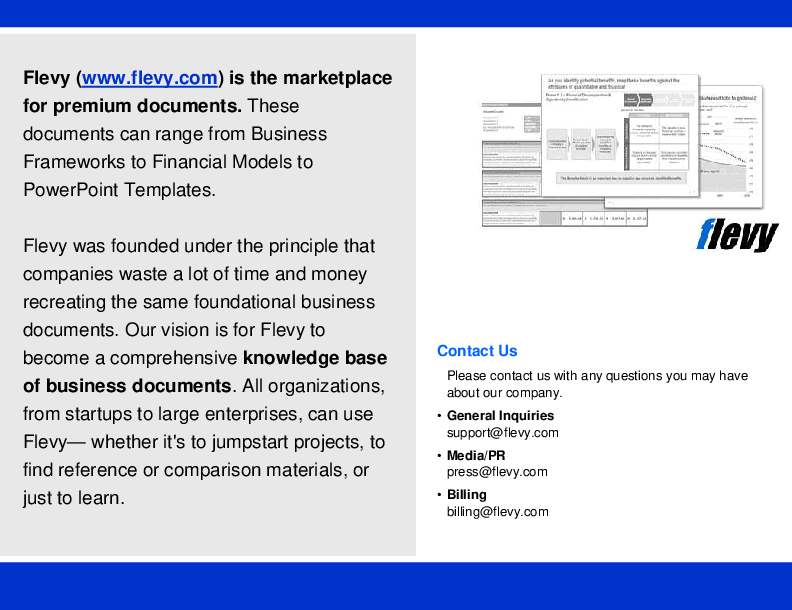Resilient Supply Chain (PowerPoint PPTX Slide Deck)
PowerPoint (PPTX) 19 Slides
BENEFITS OF THIS POWERPOINT DOCUMENT
- Provides a detailed overview and current state of Resilient Supply Chain
- Provides AI industry use cases for Resilient Supply Chain
- Provide detailed competitors benchmarking for top 5 industry players
SUPPLY CHAIN RESILIENCE PPT DESCRIPTION
Objective of the Presentation:
To understand and explore opportunities in supply chain optimization solutions in manufacturing by analysing overall demand trends, identifying potential end-user use cases, company profiling, and benchmarking major players in the market
Sections included:
Section 1 | Importance of Resilient Supply Chain Optimization Solutions
• Key drivers for the increasing importance of resilient supply chain optimization in today's market
• Recent analyst insights (market data) on the balance between efficiency and resilience in supply chain management
• Findings from recent surveys regarding the state of supply chain resilience among organizations
• Key developments in technology or market dynamics have influenced the need for resilient supply chains
Section 2 | Potential industries and Use Cases for Resilient Supply Chain Optimization Using AI/Gen AI
• Potential industries to target with proper rationale or back up with market data
• Potential and actual use cases for resilient supply chain optimization utilizing AI or Generative AI. Each use case includes – Title: What is the use case about, Challenges: What are the specific challenges, Solution: How resilient supply chain optimization was implemented, and End Result: What are the measurable outcomes or benefits achieved
Section 3 | Benchmarking of Major Players in Resilient Supply Chain Optimization
• Who are the top players in the resilient supply chain optimization space
• How do these players differentiate themselves in terms of the breadth and depth of their portfolios
• Detailed company profile for the top 5 players that includes: Major Offerings-What are their key products or services in the resilient supply chain optimization sector, Key Clients: Who are their notable clients if available, Recent Developments: What significant partnerships, collaborations, or technological advancements have they made in the last 1-2 years related to resilient supply chain optimization using Gen AI / AI
Section 4 | Conclusion
• Future trends in resilient supply chain optimization, particularly with the integration of AI and Gen AI technologies
Got a question about the product? Email us at support@flevy.com or ask the author directly by using the "Ask the Author a Question" form. If you cannot view the preview above this document description, go here to view the large preview instead.
Source: Best Practices in Supply Chain Resilience PowerPoint Slides: Resilient Supply Chain PowerPoint (PPTX) Presentation Slide Deck, Insights Locus
SUPPLY CHAIN RESILIENCE PPT SLIDES
Enhancing Logistics Networks with AI-Driven Optimization

This PPT slide presents a comprehensive overview of a use case focused on logistics network design and route optimization. It outlines the primary objective, which is to enhance the configuration of logistics networks by considering various factors like warehouse locations and transport links. The integration of Generative AI (GenAI) is highlighted, emphasizing its capability to continuously update and optimize delivery or pickup routes based on real-time variables such as traffic conditions and weather.
The section detailing target business challenges identifies key issues faced in logistics operations. It notes that routing in real-time is a significant hurdle, compounded by the complexities involved in designing efficient logistics networks. Factors such as facility location, transportation mode selection, and inventory placement are critical to overcoming these challenges. Last-mile delivery is also mentioned as a particularly intricate aspect, influenced by multiple factors including traffic congestion and customer preferences.
The AI solution segment elaborates on how AI-powered algorithms can address these challenges. It describes the use of optimization algorithms to analyze transportation costs, facility capacities, and demand patterns, which aid in designing optimal network configurations. Additionally, it mentions the role of interactive virtual assistants for drivers, enhancing route navigation and dynamic routing capabilities.
Lastly, the business benefits section quantifies the measurable outcomes achieved through these solutions. Notable figures include over 12% in freight cost savings, approximately 21% improvement in customer experience, and a 24% reduction in carbon emissions. These metrics underscore the effectiveness of the proposed AI-driven strategies in enhancing logistics operations and overall supply chain efficiency.








